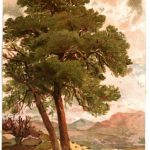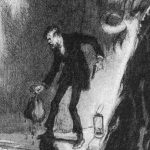 When I took my first art history course it was simple. In fact it was just as simple when I took my last art history course. Art history was like regular history: a linear progression of events, or movements, starting with cave paintings, which were prehistory really, and going up through the millenia with widely spaced high points: Egypt, Greece, Rome, then there was the Renaissance, and the rediscovery of perspective. Neo-classicism gave way to Romanticism and then Impressionism was followed by Fauvism or Expressionism. As the chronometer ticked over to the 20th century everything exploded into a bunch of isms: Cubism, Orphism, Futurism. World War I prompted Dadaism and Surrealism. Before World War II the major center of art was Paris. After World War II it was New York, with Abstract Expressionism followed by Pop Art followed by…well, if they made it to that point the art history classes just sort of fizzled out there. Nothing was left: art history had ended. For some art historians Andy Warhol’s soup cans were the capstone. For others the end had come before that: the first time a prehistoric person placed pigment on a cave wall was leading up to the moment Jackson Pollock dripped a blob of paint, breaking the connection between brush and canvas that had been the basis of all art. The greatest emphasis was on artists who were mostly white and mostly European and mostly men, artists who were centered in Italy, Paris, and New York, with brief asides to Berlin, Moscow, and London, because they were the Artists Who Mattered.
When I took my first art history course it was simple. In fact it was just as simple when I took my last art history course. Art history was like regular history: a linear progression of events, or movements, starting with cave paintings, which were prehistory really, and going up through the millenia with widely spaced high points: Egypt, Greece, Rome, then there was the Renaissance, and the rediscovery of perspective. Neo-classicism gave way to Romanticism and then Impressionism was followed by Fauvism or Expressionism. As the chronometer ticked over to the 20th century everything exploded into a bunch of isms: Cubism, Orphism, Futurism. World War I prompted Dadaism and Surrealism. Before World War II the major center of art was Paris. After World War II it was New York, with Abstract Expressionism followed by Pop Art followed by…well, if they made it to that point the art history classes just sort of fizzled out there. Nothing was left: art history had ended. For some art historians Andy Warhol’s soup cans were the capstone. For others the end had come before that: the first time a prehistoric person placed pigment on a cave wall was leading up to the moment Jackson Pollock dripped a blob of paint, breaking the connection between brush and canvas that had been the basis of all art. The greatest emphasis was on artists who were mostly white and mostly European and mostly men, artists who were centered in Italy, Paris, and New York, with brief asides to Berlin, Moscow, and London, because they were the Artists Who Mattered.
Even from the beginning, from that first art history class, there was a question in the back of my mind: what about artists in other parts of the world? Artists from Japan, the South Pacific, South America, and Africa influenced a lot of those 20th century isms, so why did the mostly anonymous artists who produced those works matter less than Manet, Van Gogh, Picasso? The history of art history follows a pretty simple pattern. Vasari, whose Lives Of The Artists is considered the first work of art history, focused on artists he knew. In the 16th century the internet was pretty rudimentary and unreliable; dial-up hadn’t even been invented yet, and that remained true up to and even through 1950 when E.H. Gombrich published The Story Of Art, the book that was either used or influenced every art history course I ever took. And I get it. In order to make sense of art, in order to make a story of art, a few scholars had to pick what they liked and cram it into an alley. And to keep the art history classes simple we students were supposed to ignore the buildings, the whole cities, the whole world on either side.
I like taking pictures of graffiti I find but I’m also always curious about the artists behind it, and some time ago created an Instagram account just to follow them, and through that I learned that an artist I’d seen, whom I only knew by the tag Betor, had died of a drug overdose on Christmas Day 2016. Or rather it helped explain some pictures I found. Through Instagram I learned Betor was part of a group of artists who worked together and influenced each other–what art historians might call a movement, or what they might label with an ism.
These works aren’t done by Betor. They’re done by friends of Betor, artists who admired his work. They’re tributes. There are more on Instagram, and messages too from artists who knew him, and others who are sorry they never met him but admired his work. I feel the same way. Betor was a person who mattered. An organization, A Betor Way, was founded in his memory to help anyone struggling with addiction.



 There is no one story of art. Art doesn’t end with the death of any artist, or with any particular movement. And if I had to give only one explanation for why I’m so interested in graffiti it would be this: because it matters.
There is no one story of art. Art doesn’t end with the death of any artist, or with any particular movement. And if I had to give only one explanation for why I’m so interested in graffiti it would be this: because it matters.






Love your point here- “there is no one story of art”- couldn’t agree more!
Thank you–and, after all, what makes art fun is that there are so many stories to be told!
You matter, Chris, and all the things that matter to you matter, too. Thanks for this post, which matters a lot to me.
Your comments, and the stories they tell, matter too, and I’m glad you contribute to the story of this blog.